Will Auburn’s NCAA Men’s 200 Free Relay Record Ever Be Broken?
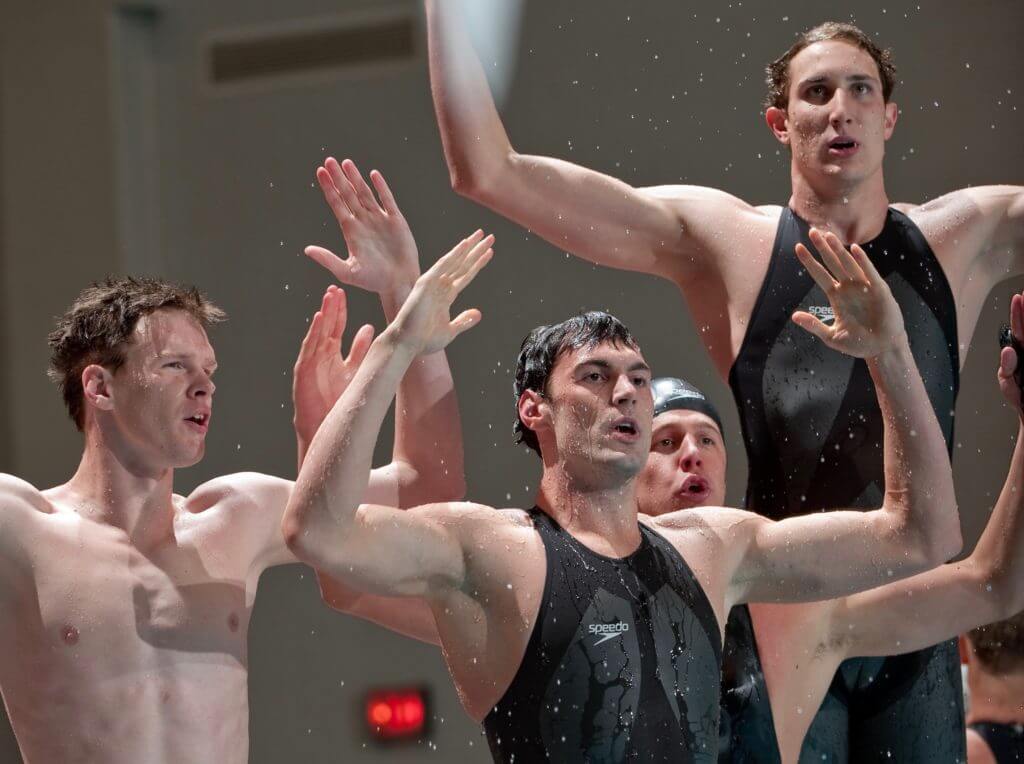
Will Auburn’s NCAA Men’s 200 Free Relay Record Ever Be Broken?
As the NCAA Men’s Championships approach, we take a look at one of the most-exceptional records in the sport, and ask when it might go down.
More than a full decade has passed since the shiny suits were outlawed in the sport of swimming, and only one NCAA record still stands from 2009 – the men’s 200 free relay. As the college-championship season heats up, does any team have what it takes to bring it down? Will it ever get broken?
The record-setting swim was done by Auburn’s quartet of Jakob Andkjaer (18.89), Gideon Louw (18.33), Kohlton Norys (18.67) and Matt Targett (18.19) of the legendary Auburn sprint program, who were coached by Hall of Fame coach Richard Quick and sprint guru Brett Hawke.
That team swam a 1:14.08, lowering the previous record set two years prior at 1:14.71, when Cesar Cielo, Scott Goodrich, Targett and Bryan Lundquist represented the Tigers at the 2007 NCAAs in one of the most impressive relays to this day. In the years since, a sub-1:15 200 free relay has been rare, and it doesn’t feel like any team has even been close to the speed of what Auburn showed in their heyday when the Tigers won six team titles in eight years in the 2000s.
Below is the race video:
The closest any team got to breaking the record was in 2018 when Florida won with four seniors led by Caeleb Dressel’s other-worldly 17.86 on the leadoff leg, touching at 1:14.39.
In the years since the shiny suits were outlawed in late 2009, only four schools have been able to put together a relay under 1:15. Below are the fastest for each:
- 1:14.39, Florida (Dressel, Switkowski, Martinez-Scarpe, Szaranek) 2018
- 1:14.46, California (Sendyk, Hoffer, Jensen, Seliskar) 2019
- 1:14.50, NC State (Held, Ress, Molacek, Stewart) 2018
- 1:14.59, Texas (Ringgold, Conger, Jackson, Schooling) 2017
Dressel’s 17.8 on the leadoff leg in 2018 was so insane that people seemingly forgot that the relay had gotten closer than anyone had to that 1:14.08 Auburn record. It has stood so long that it almost seems mythical – Louw is now an assistant coach at Auburn and Targett is making a comeback in the pool while Norys is a Real Estate Mogul on the west coast.
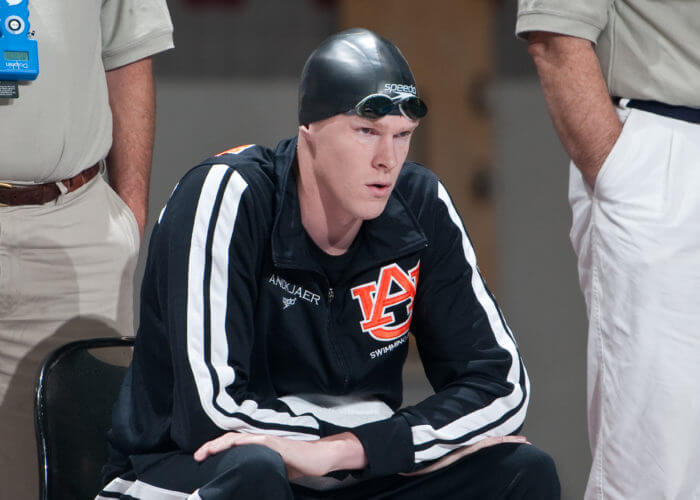
Jakob Andkjaer. Photo Courtesy: Peter H. Bick
The other four short course relays have seen tremendous improvement since the shiny suit era of 2009 – the 800 free being the most significant dropping from a 6:10 record in 2009 to a 6:05 in 2019 (five schools went faster than a 6:10 at the 2019 NCAAs). The 200 medley has dropped from a 1:22.3 to a 1:21.5 and the 400 medley went from a 3:01 to a 2:59 within the last ten years. The 400 free relay was a 2:46 in 2009 and the record now stands at 2:44. Not to mention, every single other 2009 American and NCAA record in short course yards has been erased – leaving the 200 free relay as the last one standing.
So why has that Auburn record remain untouched?
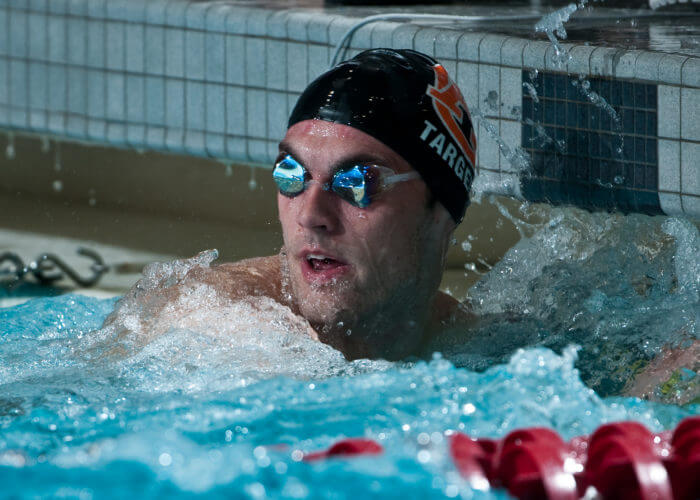
Matt Targett. Photo Courtesy: Peter H. Bick
Auburn’s relay averaged an 18.52 across the four swimmers, and no college man outside of Dressel has gone that fast from a flat start since Targett in 2009. In fact, only three men – Dressel, Targett and Cielo – have ever gone that fast from a flat start. So to find four men that can hop up on the blocks and go that fast is already a challenge in itself.
The 200 free relay was often a big highlight for the NCAA meet – for many years it would kick off the Thursday night session to open the championships. It was fast, exhilarating, and intense. Adrenaline was always running high on the first night of finals and when those eight leadoff men dove off the blocks in the final, it would often be the loudest, and most anticipated, event of the meet.
With the amount of world class sprinters that came through Auburn’s program in the 2000s, the 200 free relay was a flex of power for the Tigers, who won five 200 free relay national titles in six years from 2004 to 2009. If anyone had designs of standing on top of the podium to open the meet Thursday night, they would need to go through the Auburn Tigers.
Auburn had raced that night next to Stanford, who swam a 1:14.22 and still remains the second fastest relay of all-time. The race, which can be viewed above, was back and forth between Auburn and Stanford.
The Cardinal had Alex Coville (18.97), Austin Staab (18.28), Jason Dunford (18.45) and David Dunford (18.52), giving the Tigers all they could handle every step of the way, with Targett needing everything he could muster to catch Dunford on the anchor leg. That year, Auburn, Texas and Stanford were the favorites for the team title, and it was imperative for those teams to play to their strengths and get off to a good start. Auburn’s head coach Richard Quick had been in the hospital during the meet fighting brain cancer and was absent from the deck, leaving the Tigers inspired to win in his absence.
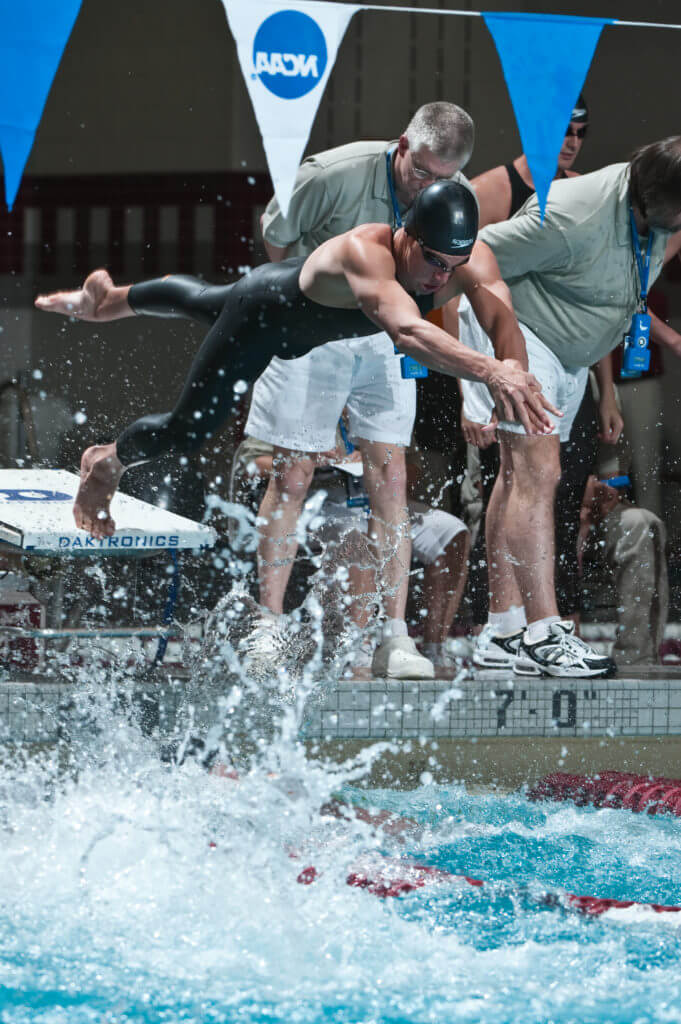
Kohlton Norys. Photo Courtesy: Peter H. Bick
Auburn’s three swimmers averaged 0.20 on their relay takeovers in 2009 – compared to Florida’s winning relay in 2018 which averaged 0.28 on their three relay takeovers. Could that little bit of a difference have been what separated the Tigers from the Gators? Maybe. And in a 50 free, there’s so many little things that the swimmer needs to hit perfectly that there is zero room for error.
Another obvious reason why the record still stands is the swimsuits worn. Targett and Louw were in Speedo LZR racers, while Norys and Andkjaer were in Jaked suits, an Italian company that had released a polyurethane suit that contributed to the mauling of the record book in the 2009 calendar year. These suits allowed the swimmers to sit higher in the water and it would propel off of them better than any suit that had come before them. Diving in and racing in one of those suits was a confidence booster in itself – the athletes knew they would swim fast.
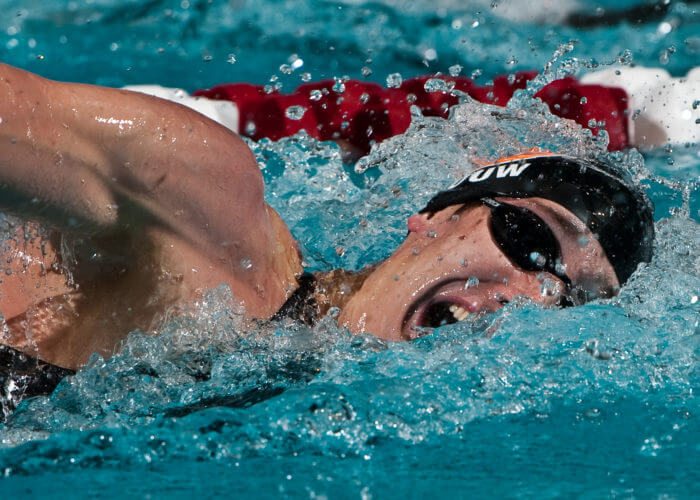
Gideon Louw. Photo Courtesy: Peter H. Bick
The adrenaline of the first night, coupled with the feeling of gliding effortlessly through the water, along with the emotions of wanting to gain some momentum on the first night of the meet, made for some fast swimming, and that 200 free relay was an indication.
Even Arizona’s women’s 200 free relay record set a week prior at 1:26.2 had lasted for eight more seasons, finally falling in 2017. If there was one event that the shiny suits affected the most, it would be the 50 freestyle. Multiply that x4 and you have one of the most difficult records to break.
Is the record in danger of falling?
Any record can be broken at any given championship meet, and depending on whether an NCAA meet can happen this year, that 1:14.08 will be there on the heat sheets as a benchmark for the schools to reach. Last year, Cal had the top time in the nation at 1:15.54, the only school to break 1:16 through the conference championships before the meet was cancelled.
The Golden Bears had the top two times in the nation last year in the 50 in Ryan Hoffer (18.87) and Pawel Sendyk (18.91), as well as Michael Jensen and Zheng Quah on their Pac-12 relay that certainly would have taken aim at that record. We never got to see the 2020 NCAA championships due to the COVID-19 pandemic, but it is likely that the Golden Bears had designs of achieving that record whether they would have reached it or not.
Obviously you never want to say never, but there is a huge difference in a 1:14.07 versus a 1:14.99. Breaking 1:15 is difficult, but breaking 1:14 is like finding a needle in a haystack. But once one team breaks through with a sub-1:14, it will open the door for another team to make that step forward.
It’s going to take an almost perfect swim to break the 200 free relay NCAA record, but no one thought a man could break 18 seconds from a flat start and then Dressel did it, so it’s bound to happen at some point. Will it be this year? Next year? Ten years from now? Who knows.
Even with the shiny suits being outlawed at the end of 2009, swimming has changed dramatically in the last decade. With only jammers permitted by male swimmers, core strength has become a sense of importance, and underwater kicking is almost a requirement for any sprinter wishing to break 19 seconds. In the race video from 2009, only Austin Staab kicked past 10 yards underwater off of his turn, whereas in the 2019 200 free relay final 10 years later, around 12 swimmers out of the 32 finalists kicked underwater past 10 yards off of the turn.
The sport is becoming more and more athletic, with dolphin kicking and power off the blocks becoming more of an importance.
With the addition of the wedge blocks in 2010 and the step-over relay starts in 2014, the start has become a much more athletic movement for swimmers, requiring swimmers to erase the age-old adage that they are not land athletes, and requiring them to be more explosive. And with more and more coaches realizing that underwater kicking is often just as fast compared to swimming on top of the water, the 50 free is almost a completely different looking event from where it was 10 years ago.
Yes, the shiny suits are no longer around, but every single NCAA and American record in short course yards has fallen since 2009 except for the 200 free relay, and it is a testament to how impressive that swim really was nearly twelve years ago at one of the fastest NCAA meets of all-time. The question remains: can the record get broken, and who will be the team to do it?




WAR EAGLE
An absolutely amazing and inspiring performance. However, it will, of course be broken, and sooner than we all think. Why? Because that is the US swimming way.